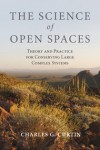
My late summer reading list included Charles Curtin’s book The Science of Open Spaces: Theory and Practice for Conserving Large Complex Systems (Island Press 2015). In so many ways this is the book I have been waiting for. As the title promises it tackles working on a landscape scale from the ground up with examples from the US borderlands in New Mexico, to the seacoasts of Maine and then on to Ambesoli National Park in Africa. But Curtin is not just a keen raconteur, he also takes a deep scholarly dive into the theories that underpin this work – chaos, complexity and resilience to name just a few.
Do not be deterred by the term “open spaces”. As he use the phrase to sweeping effect defining its use “to invoke not only the challenge of physical size but also of time, ecology, culture and all elements therein.”
Using his broad ranging experiences, he tries to identify the recurrent patterns in landscape scale project across these different geographies seeking out common strategies and ways to sustain them. He calls out the need to go beyond conventional research in ecology and conservation and understand the social dynamism in which these ecosystem exists.
It would be impossible to summarize the range of theoretical mountains that the book traverses as it pursues a foundational basis for the field of landscape scale conservation. So I have just selected a few paths that resonated for me from my observations in the field of large landscapes such as National Heritage Areas and Pennsylvania’s Conservation Landscapes. These include:
- The importance of local knowledge as the key to how people relate to their environment. And the crucial role place based actions play in conserving and maintaining large landscapes.
- The multiple challenges of sustaining support particularly funding support for this work over the long haul.The importance of a third party convener or as he calls it a “backbone organization” in providing unity and focus. Someone who can take both a local and high-level viewpoint, after all he notes “…there are limit to what one neighbor can tell another.
- The needs for diversity of perspectives to tackle the complexity of landscape conservation to provide a wide range of potential solutions and build a resilient system. What he calls distributed cognition is build on the time-consuming process of collaboration and as he states “…there are not short cuts.”
- The importance of adaptation and feedback loops to success and the need to look at both ecological and social factors.
- And most importantly the role of power. Curtin make it clear “In building sustainability and effectively conserving open spaces addressing power relationships in not an issue- it is the issue”
Well I could go on and on, and I have not even tried to summarize the book’s theoretical underpinnings. Just buy the book. Every reader will appreciate the well-presented case studies and for those who have worked in the trenches struggling with landscape scale conservation efforts, I guarantee there will be many aha moments.


